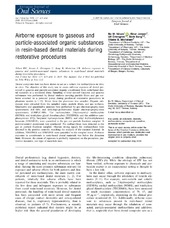| dc.contributor.author | Nilsen, Bo Wold | en_US |
| dc.contributor.author | Jensen, Einar | en_US |
| dc.contributor.author | Örtengren, Ulf | en_US |
| dc.contributor.author | Bang, Berit | en_US |
| dc.contributor.author | Michelsen, Vibeke Barman | en_US |
| dc.date.accessioned | 2020-05-13T09:05:05Z | |
| dc.date.available | 2020-05-13T09:05:05Z | |
| dc.date.issued | 2019-10 | |
| dc.Published | Nilsen B, Jensen e, Örtengren U, Bang BE, Michelsen VB. Airborne exposure to gaseous and particle-associated organic substances in resin-based dental materials during restorative procedures. European Journal of Oral Sciences. 2019;127(5):425-434 | eng |
| dc.identifier.issn | 0909-8836 | |
| dc.identifier.issn | 1600-0722 | |
| dc.identifier.uri | https://hdl.handle.net/1956/22218 | |
| dc.description.abstract | Dental composite dust has been shown to act as a vehicle for methacrylates in vivo/in vitro. The objective of this study was to assess airborne exposure of dental personnel to gaseous and particle‐associated organic constituents from resin‐based dental materials in a simulated clinic. Sampling of total aerosol fractions and gaseous substances was performed by dental students carrying particle filters and gas sorbents attached to a personal pump during preclinical restorative procedures in phantom models (n = 13). Water from the phantoms was sampled. Organic substances were extracted from the sampled water, particle filters, and gas sorbents. Qualitative and quantitative analyses were performed by gas chromatography‐mass spectrometry (GC‐MS) and ultra‐high‐performance liquid chromatography‐mass spectrometry (UHPLC‐MS). The methacrylates 2‐hydroxyethyl methacrylate (HEMA) and triethylene glycol dimethacrylate (TEGDMA) and the additives camphorquinone (CQ), butylated hydroxytoluene (BHT), and ethyl 4‐(dimethylamino)benzoate (DMABEE), were quantified in the gas and particle fractions sampled. A positive‐control experiment was conducted. No methacrylates were detected in the gas or particle fractions sampled, whereas strong signals for methacrylates were detected in the positive controls, matching the analysis of the uncured material. In addition, TEGDMA and DMABEE were quantified in the sampled water. Airborne exposure to constituents in resin‐based dental materials was below the detection limit. However, the extent of exposure is probably dependent on the procedure, preventive measures, and type of materials used. | en_US |
| dc.language.iso | eng | eng |
| dc.publisher | Wiley | eng |
| dc.rights | Attribution CC BY | eng |
| dc.rights.uri | http://creativecommons.org/licenses/by/4.0/ | eng |
| dc.subject | air pollutants | eng |
| dc.subject | dentistry | eng |
| dc.subject | methacrylates | eng |
| dc.subject | occupational | eng |
| dc.subject | operative | eng |
| dc.subject | particulate matter | eng |
| dc.title | Airborne exposure to gaseous and particle-associated organic substances in resin-based dental materials during restorative procedures | en_US |
| dc.type | Peer reviewed | |
| dc.type | Journal article | |
| dc.date.updated | 2019-12-09T14:31:26Z | |
| dc.description.version | publishedVersion | en_US |
| dc.rights.holder | Copyright 2019 The Author(s) | |
| dc.identifier.doi | https://doi.org/10.1111/eos.12646 | |
| dc.identifier.cristin | 1720805 | |
| dc.source.journal | European Journal of Oral Sciences | |

